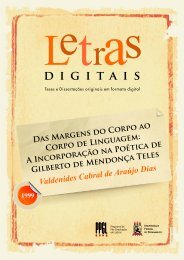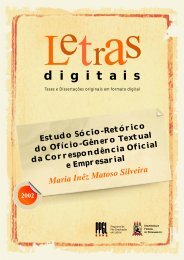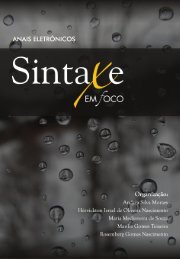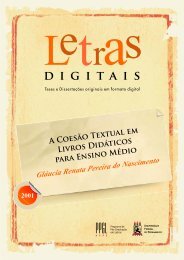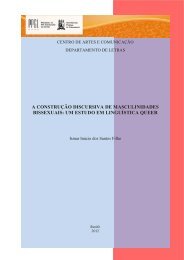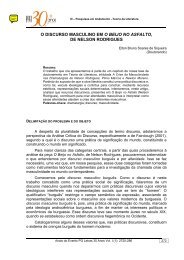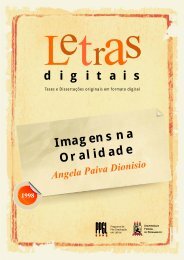- Page 1 and 2: UNIVERSIDADE FEDERAL DE PERNAMBUCO
- Page 4: VERGÍLIO FERREIRA: PARA SEMPRE, RO
- Page 7 and 8: AGRADECIMENTOS Diz Fernando Pessoa,
- Page 9 and 10: EPÍGRAFES DE VERGÍLIO FERREIRA So
- Page 11: RÉSUMÉ Analyse de l’ensemble de
- Page 15 and 16: INTRODUÇÃO
- Page 17 and 18: 15 romances disponíveis -, o conju
- Page 19 and 20: 17 livro (como em Para sempre, por
- Page 21 and 22: 19 de coisas não previsíveis (pel
- Page 23 and 24: 21 se lhe seguiram. Na aldeia, abri
- Page 25 and 26: 23 mas da existência do Homem. Ess
- Page 27 and 28: 25 sim. As artes do Modernismo não
- Page 29 and 30: 27 Nasci em Melo, na serra da Estre
- Page 31 and 32: 29 do que dele poderiam representar
- Page 33 and 34: 31 que só o decurso do tempo, a di
- Page 35 and 36: 33 riedade ou na constante mutaçã
- Page 37 and 38: 35 não se cruzavam com os escolhid
- Page 39 and 40: CAPÍTULO I MODIFICAÇÃO E PERMAN
- Page 41 and 42: 39 obra como algo em constante evol
- Page 43 and 44: 41 Chovera. Pela tarde, nesse fim d
- Page 45 and 46: 43 Portanto, temos o hegelianismo,
- Page 47 and 48: 45 sava e lhe falava “ao ouvido,
- Page 49 and 50: 47 pela obediência, respeito e sol
- Page 51 and 52: 49 tantes elos de ligação entre r
- Page 53 and 54: 51 A escrita de A. Lopes, ainda que
- Page 55 and 56: 53 No sentimento de Antônio Santos
- Page 57 and 58: 55 que recorda pertencem os aspecto
- Page 59 and 60: Ao sentido de continuidade, present
- Page 61 and 62: 59 lógico-filosófica, o romance,
- Page 63 and 64:
61 O suicídio passa a ser tema de
- Page 65 and 66:
63 Não. Ninguém gritou. Só o sil
- Page 67 and 68:
65 romance do escritor inglês, esm
- Page 69 and 70:
4. CÂNTICO FINAL. Entre a Arte e a
- Page 71 and 72:
69 so, para depois da vida, para de
- Page 73 and 74:
71 Longa, a citação, mas justific
- Page 75 and 76:
73 mo um qualquer valor humano - o
- Page 77 and 78:
75 renascer, da fertilidade... E é
- Page 79 and 80:
77 então estava escrevendo e que e
- Page 81 and 82:
79 conta a Mário - com uma intenci
- Page 83 and 84:
81 - Esquece, esquece. Se puderes.
- Page 85 and 86:
preendeu, também, no erotismo 26 ,
- Page 87 and 88:
85 traziam consigo o mistério da u
- Page 89 and 90:
CAPÍTULO II APARIÇÃO / “APARI
- Page 91 and 92:
89 a Carlos a afirmativa de que “
- Page 93 and 94:
91 vel, que sobra ainda de um corpo
- Page 95 and 96:
93 dos em destaque na abertura e no
- Page 97 and 98:
95 ciência da finitude a que esse
- Page 99 and 100:
97 tempo vivenciada por Alberto só
- Page 101 and 102:
99 ria, Aparição é um romance
- Page 103 and 104:
101 gestos humanitários, como a ad
- Page 105 and 106:
103 Biliões e biliões de homens p
- Page 107 and 108:
105 tu eras alguma coisa mais do qu
- Page 109 and 110:
107 avó paterna de Alberto, mas, q
- Page 111 and 112:
da “comunhão absoluta”. Vergí
- Page 113 and 114:
111 face de si mesmos e de um mundo
- Page 115 and 116:
113 A transcrição deste fragmento
- Page 117 and 118:
115 Universo vai terminar com a sua
- Page 119 and 120:
117 em crise, é inalcançável e p
- Page 121 and 122:
119 Desde Manhã submersa, passando
- Page 123 and 124:
121 Não escrevo para ninguém, tal
- Page 125 and 126:
123 da diegese sustenta-se na pecul
- Page 127 and 128:
125 tudo se fecha - como num círcu
- Page 129 and 130:
127 nascer e que vai integrar a sua
- Page 131 and 132:
129 berto a não matou diretamente,
- Page 133 and 134:
131 rocha, penhasco, e esta parece
- Page 135 and 136:
133 esse aviso de uma palavra decis
- Page 137 and 138:
135 Montanha seria essa espiral apo
- Page 139 and 140:
137 do meio ambiente com a “tecni
- Page 141 and 142:
139 É esta aldeia isolada do mundo
- Page 143 and 144:
141 as coisas muitas vezes - influ
- Page 145 and 146:
143 - Deus é uno e imutável, e a
- Page 147 and 148:
145 música suave, direi mesmo deli
- Page 149 and 150:
147 que abandonou a terra e o quoti
- Page 151 and 152:
149 que era verdade. É absurdo, nu
- Page 153 and 154:
151 morte da terra que Jaime Faria
- Page 155 and 156:
153 Também ecos de outros autores,
- Page 157 and 158:
155 A segunda parte de A terra deso
- Page 159 and 160:
157 Se aqui só água houvesse em m
- Page 161 and 162:
159 De estrutura, também, mas com
- Page 163 and 164:
tomadas exteriores com destaque par
- Page 165 and 166:
163 1. NÍTIDO NULO: Quase ao entar
- Page 167 and 168:
165 aparente de todo quanto à tran
- Page 169 and 170:
167 da palavra, toda uma vida passa
- Page 171 and 172:
169 assim, ele reivindica uma lógi
- Page 173 and 174:
171 Estou só. E o universo à minh
- Page 175 and 176:
173 Jorge, o diálogo “chegou a m
- Page 177 and 178:
175 À cena da estupefação de Jor
- Page 179 and 180:
177 de contraponto com o esvaziamen
- Page 181 and 182:
179 Se a história e a psicologia d
- Page 183 and 184:
181 Adalberto, Jaime e particularme
- Page 185 and 186:
183 51) - “a trompete [sic] há-d
- Page 187 and 188:
185 cuspido e humilhado e amarrado
- Page 189 and 190:
187 de fundar um novo mundo e um no
- Page 191 and 192:
189 quintal uma flor silvestre, ama
- Page 193 and 194:
191 de-se com a ilusão da presenç
- Page 195 and 196:
193 - Assi que todollo pregoeiro de
- Page 197 and 198:
195 Voltarei a tratar das transgres
- Page 199 and 200:
197 transgressões praticadas no ro
- Page 201 and 202:
199 Tenho de explicar a morte da ti
- Page 203 and 204:
da espiral, sem que a circunferênc
- Page 205 and 206:
203 rados. Associa-se a uma certa f
- Page 207 and 208:
205 A rememoração do passado de J
- Page 209 and 210:
207 mais do que um processo de subs
- Page 211 and 212:
209 monte a monte, no mais secreto
- Page 213 and 214:
211 tia asperamente - onde o signif
- Page 215 and 216:
213 Era um quadro todo preto como a
- Page 217 and 218:
215 É uma casa nua, as paredes lis
- Page 219 and 220:
217 morto esse duplo, dá-se, por c
- Page 221 and 222:
219 O orador já estava de pé sobr
- Page 223 and 224:
221 falta para morrer” (p. 47) e
- Page 225 and 226:
223 algumas janelas já acesas. Reg
- Page 227 and 228:
quando regressa a casa, com vento e
- Page 229 and 230:
227 meio para amanhã o continuar,
- Page 231 and 232:
229 não só: também a esperança
- Page 233 and 234:
231 como um romance de discurso, en
- Page 235 and 236:
233 fim”. 56 Seis anos antes, já
- Page 237 and 238:
235 É de certo modo impressionante
- Page 239 and 240:
237 O que fica pairando no texto s
- Page 241 and 242:
239 tiva perde os seus functores, o
- Page 243 and 244:
241 frâmio acabou (ou a guerra que
- Page 245 and 246:
firmação da hipótese. Por exempl
- Page 247 and 248:
245 teóricos e algo doutrinários,
- Page 249 and 250:
247 de rituais sagrados de poesia e
- Page 251 and 252:
249 O bolo pascal é um outro “co
- Page 253 and 254:
251 toda uma cacofonia onomatopaica
- Page 255 and 256:
tação da mulher bela e pura, pres
- Page 257 and 258:
255 da nossa confusão. Fiadas de c
- Page 259 and 260:
257 INTRODUÇÃO CAMÕES, Luís de.
- Page 261 and 262:
259 SIMÕES, João Gaspar. Cântico
- Page 263 and 264:
261 BAUDELAIRE, Charles. As flores
- Page 265:
__________ . Vergílio Ferreira, os




